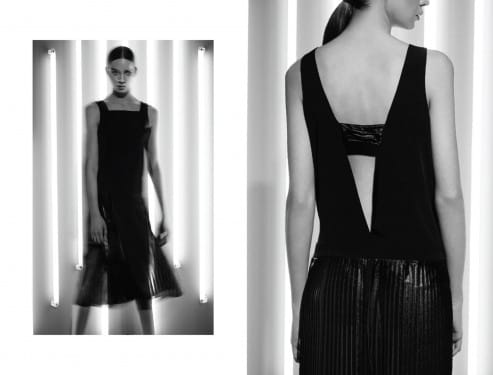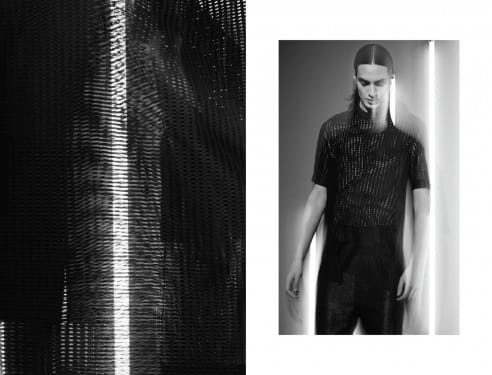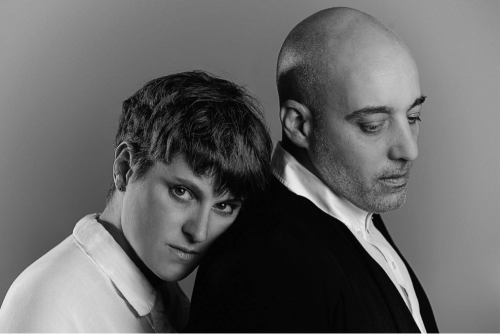The Art of Emiliano Blanco and Camila Milessi
I close my umbrella, shake a few raindrops off, ring the bell, and am immediately invited inside. As I enter the Kostüme atelier in the hood of Colegiales, Buenos Aires I recognize old images of past fashion productions hanging on the hallway walls.
While I'm waiting, I try to absorb every detail of the house. I can hear Emiliano Blanco talking about pattern correction for samples, Camila Milessi setting up the office for the meeting and the young interns coming and going with hangers full of clothes. Once inside the small but functional office I sit and talk with the two creators of Kostüme.
Milessi graduated with a Fashion Design Degree from Buenos Aires University in the 1990s. She then continued her professional career working for different commercial brands for the next ten years. There she learned how to manage different links of the fashion industry chain.

ph: Luciana Val & Franco Musso
Make up: Jazmin Calcarami Estudio
Hair: Juan Olivera
Styling: Kostüme & Caro Urresti
Space: Punto Ese
Digital retouch: Studio 12
Models: Romina Hartwig & Martín Grinspun. Civiles.
Also during the early ‘90s, Blanco started designing and learned how to construct a strong commercial structure during his time at various commercial fashion brands.
Milessi and Blanco met each other working in one of these brands. They started as co-workers but soon fell in love with each other´s vision and similar ideas, which became the key to their prosperous independent fashion brand.
Milessi remembers her years working at others’ companies as a hard time. "To get paid was almost a miracle”, she says. This was due to the Argentine economy’s fluctuation in the early 2000s. 2001 was a year of deep social and economic distress in Argentina. After industrial debilitating policies of the ‘90s, the next weak and unstable government produced an environment where opportunity depended on creativity. Kostüme was born in a rough economy, which the duo used as inspiration for their aesthetic structure. "Form follows function, and less is more" is Blanco’s mantra.
The initial years of Kostüme were sustained on the pair’s income from designing for other companies and coaching young entrepreneurs. This way they didn’t have to sacrifice their independence for commercial profit.
Milessi explains, "It was like an art gallery, based on our own taste and financed by our sacrifice. It was like a serious hobby. We wouldn't abandon our identity just for money. Otherwise, we would have sold hot dogs instead". It was a declaration of principles.
Blanco continues, "When you are new you can take commercial risks and that gives you an strong commercial identity. That's a risk we cannot take now because of our current trade structure. But the challenge is to reinvent yourself every season with the same minimal manifesto".

ph: Luciana Val & Franco Musso
Make up: Jazmin Calcarami Estudio
Hair: Juan Olivera
Styling: Kostüme & Caro Urresti
Space: Punto Ese
Digital retouch: Studio 12
Models: Romina Hartwig & Martín Grinspun. Civiles.
As with many contemporary procedures in art and design, randomness is a big factor in the duo’s creative process. It allows them to construct fresh new silhouettes. Taking inspiration from Pierre Cardin, the pair often mixes items to create new, radical designs. Blanco and Miselli identify themselves as people who do what everybody else does, but with influences from things like abstraction and disruptive new forms of expression such as punk and modernism to set them apart.
What started as an aesthetic decision based on functionality and minimalism became a new platform for conversation about sexuality and gender. Blanco relates an anecdote about one Norwegian customer who chose a women’s dress, leggings, boots and a leather jacket to wear to his opening night at the theatre.
The duo decided to create garments for customers with strong identities who prefer enigmatic sensuality to overt sexuality. However, the firm doesn't want to overshadow the customer. They explain that the clothes cannot mean more than the person underneath.
The two get different inspirations from other disciplines, such as art and authors. They then reconstruct their own story on a fashion platform. They also sometimes turn to other local artists for their talent as photographers, filmmakers and choreographers to complete their visions. Their last season’s spring/summer collection called #OurVision #30 celebrated their 15 years on the local fashion scene with an installation by sound artist Nicolás Varchausky who used a cube made of light and motion sensors to compose the music for the non fashion runway show. Photographers Clara Cohen and Juan Antonio Papagni helped capture the presentation.
Since collection #27 they have started to work with filmmaker Nicolás Puenzo and choreographer Andrea Servera to create beautiful fashion films where models and dancers move freely and exchange fashion pieces.
After many years in the fashion business, Kostüme got a school professorship at UP (Palermo University). They ensure future industry members are ready for the real world. "We think universities need teachers who compete in the market", both agree. Fashion is full of fantasies such as fame, fortune, access, exclusivity, and glamour. I guess most of those ideas don't die during the school years because we know deep down inside that most people still buy into those aspirations in life. It is necessary to prepare future generations for the work that they will have to go through,
In the last few years, Kostüme has had the chance to sell in the Japanese market. "It was a very exhausting moment in our career because we had to became even more professional. But we are really glad we did because that experience updated our company structure. it's really hard to compete with other countries’ quality because of our country’s international economic policies and the lack of high quality materials that consumers expect. But we manage with what we can. We are survivors", says Blanco. "I'm Kate Winslet on the Titanic. We can make until the end. They won't get us,” adds Milessi.
Survivors they are, and personally I cannot wait to see what comes next.

Camila Milessi & Emiliano Blanco. Ph: Juan Papagni Meca.
